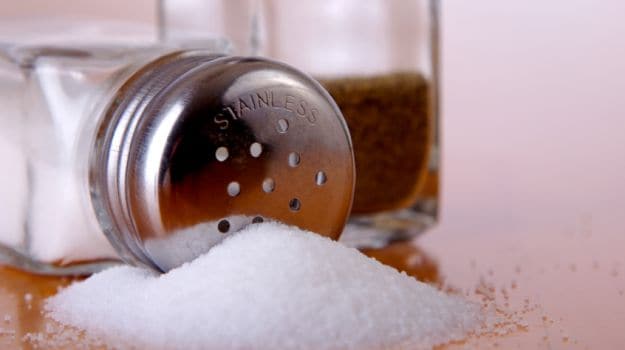It’s Clear – We All Need to Take Salt Off the Table

Image credit: Istock
After all this time, why don’t we know for sure whether eating too much [FILL IN THE BLANK] is bad for us?
You can fill in that blank with saturated fat, with meat, with cholesterol, and the answer’s the same, because the kind of research that would definitively answer that question is impossible to do. We can’t hold large groups of people captive, feeding them a specific kind of diet until they die from it – or don’t. The studies in which people are held captive are necessarily too short to reveal long-term effects, and the other studies, in which we try to draw conclusions from what free-living people eat, are complicated by all the other things those free-living people do.
There is, however, one thing you can’t fill in the blank with, and that’s salt.
But wait! You’ve seen the he-said, she-said back-and-forth about salt. The “some studies say this, but other studies say that” gambit is familiar to anyone who writes about – or reads about – the link between diet and health.
And it’s true that there’s some of that with salt. Some studies don’t find higher salt intake to be risky, or even find that lower salt intake correlates with a higher chance of dying. A 2011 study that followed nearly 3,700 people for eight years didn’t find higher risk at higher sodium levels, and it concluded that the findings “do not support the current recommendations of a generalized and indiscriminate reduction of salt intake at the population level.” Two years later, a review of research on long-term salt reduction concluded that there’s a significant benefit in the form of reduced blood pressure, results that provided “strong support for a reduction in population salt intake.”
A 2014 study of more than 100,000 people from 17 countries found that sodium consumption “between 3 g per day and 6 g per day was associated with a lower risk of death and cardiovascular events than was either a higher or lower . . . intake.” (That’s between 3,000 and 6,000 milligrams, by the way, significantly more than the U.S. government’s proposed guideline of 2,300 milligrams a day or less.) And a recent report from the Institute of Medicine highlighted possible dangers from too little sodium and concluded that there’s no reason to go below the U.S. guideline.
But we have research on salt that cuts through that confusion. Research that’s much closer to the impossible, definitive kind. We have population-wide studies that lowered sodium intake for just about everyone, without their knowing it. Opportunities to do that kind of research don’t come up often, because the food under study has to be incorporated into processed food and restaurant food (so it doesn’t require individual consumers to choose to make a change), and it has to be replaceable in a way that consumers won’t notice. The recent phasing-out of trans fats in this country will give us a chance to do a similar study.
Meantime, though, we have salt. And the best-documented population-wide reduction was in the United Kingdom.
In 2003, a government-commissioned report on salt concluded that high salt consumption in the British population was contributing to cardiovascular disease and stroke. Individual recommendations to people with hypertension wouldn’t get the job done, the report said. “A public health approach to reducing salt levels is required.” The U.K.’s Food Standards Agency responded with a two-pronged salt-reduction plan. The first prong was increasing public awareness. The second, critical prong was working with the processed-food industry to reduce salt in their products.
And, with that second prong, they had the makings of a population-wide experiment. If salt levels came down in processed foods, without fanfare and at rates ensuring that consumers wouldn’t notice, salt intake would be reduced across the board, and there ought to be population-wide reductions in the health problems salt is suspected of playing a role in: cardiovascular disease and stroke, primarily.
Graham MacGregor is professor of cardiovascular medicine at the U.K.’s Wolfson Institute of Preventive Medicine and heads the Consensus Action on Salt and Health, the group that initiated negotiations with the food companies. “We worked very closely with them on how to do it,” he says. “We set targets for foods in 86 categories: bread, cereals, soups, and so on.” The targets were geared to see a 10 to 15 percent reduction within four years and to be revisited every two years for adjustment.
In 2003, when the study began, Britons’ salt intake averaged 9.5 grams per day. (In the United States, we generally measure salt by its sodium content, which is a little less than 40 percent of salt’s weight, so 9.5 grams of salt corresponds to 3,740 milligrams of sodium.) By 2011, consumption had dropped 15 percent, to 8.1 grams per day, or 3,190 milligrams. Blood pressure dropped commensurately. Stroke mortality dropped by 42 percent, heart disease by 40 percent.
Those are jaw-dropping numbers, and the drop is not due just to salt reduction, because other things happened in that time period. Smoking dropped (from 19 percent of the population to 14 percent), and fruit and vegetable consumption rose slightly (by about one-fifth of a portion per day), both good things. On the other hand, body mass index (BMI) increased a half-point (that’s seven pounds on a 5-foot-10 person), which wouldn’t have helped. The study also attributes at least part of the decrease to “improvements in the treatments of BP [blood pressure], cholesterol and cardiovascular disease.”
MacGregor points out that two other countries that instituted similar population-wide salt reduction programs, Japan and Finland, also saw big drops in disease. (Finland’s program resulted in a 30 percent decrease in salt intake over a 20-year period, and a 75 to 80 percent decrease in deaths from stroke and heart disease. In 2007, Finnish sodium intake was 3,660 milligrams for men and 2,680 for women.)
Meanwhile, back at the ranch, deaths in the United States from stroke and heart disease have fallen, as well – just not as much. According to the Centers for Disease Control, in the period when U.K. deaths dropped by 42 percent and 40 percent, respectively, U.S. deaths dropped 31 percent and 34 percent (although the U.S. and U.K. may calculate the rates differently, so they aren’t perfectly comparable). Some of the same factors were at work: Smoking dropped a bit, our BMI increased, and care improvements were probably commensurate. The biggest difference is salt. Average U.S. sodium consumption is 3,440 milligrams a day and has been flat from 2003 to 2010, the last year for which I’ve been able to find data.
Even with this kind of research, we can’t say with absolute certainty that the salt decrease is responsible. But the compelling data from countries that have tried population-level decreases have led both the World Health Organization and the United Nations to recommend such programs as a way to fight disease. According to MacGregor, 50 or 60 countries have copied the U.K. model and have programs in the works.
Seems we could be a candidate for a similar program, but it would have to be over the objections of the Grocery Manufacturers Association. Roger Lowe, the group’s executive vice president of strategic communications, points out that processed-food companies have already voluntarily decreased salt content of some foods by an amount “equivalent to over 100 mg sodium per day” per person, and they’ve allocated resources “to products which have the largest impact on sodium intakes.” Were they required to meet targets for each category, as in the U.K. (although the standards were not government-imposed, but negotiated), that would “force companies to divert resources to products in their portfolio with relatively minor impact on overall sodium intake.”
Despite the association’s focus on the foods most likely to generate reduced sodium intake, the group’s salt reduction has not affected U.S. consumption at all. Lowe acknowledges that, and he speculates that it’s “because of the trend of more foods consumed away from home.” Even so, had the association’s reduction been reflected in overall consumption, that 100-milligram cut corresponds to a quarter-gram of salt, or less than one-fifth of the drop in British consumption.
One of the keys to the success of the British initiative was that it wasn’t shouted from the rooftops. There were no labels along the lines of “Now with less salt!” because consumers are notoriously apt to avoid products labled in that way, believing that they don’t taste as good. (Some, but not all, of the association’s reduction comes from low-sodium products.) Instead, salt levels in foods across the spectrum dropped slowly – so slowly that nobody noticed.
Here in the United States, there are lots of policy options to improve public health – education, taxes, labeling, research, ingredient limits – and arguments rage about their efficacy and appropriateness. There are no guarantees, even for programs that have succeeded in other places. Our population starts with a lower salt intake than the U.K. population did, our implementation is bound to be different, and there’s just no knowing what people will decide to eat tomorrow. The best we can do is try the programs with the best chance of success, and that sure looks like population-wide salt reduction to me.
[“source-ndtv”]




